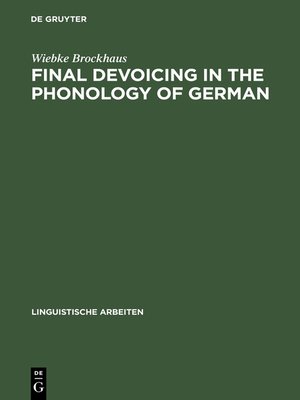
Sign up to save your library
With an OverDrive account, you can save your favorite libraries for at-a-glance information about availability. Find out more about OverDrive accounts.
Find this title in Libby, the library reading app by OverDrive.



Search for a digital library with this title
Title found at these libraries:
| Library Name | Distance |
|---|---|
| Loading... |
This book deals with the phonological event of final devoicing in a theoretical framework based on principles and parameters rather than rules. It refers to data coming almost exclusively from German (native and non-native items).
The first chapter presents the 'raw facts', providing an outline of the sort of alternations and distributional restrictions on voicing to be accounted for. Previous treatments of final devoicing in German are discussed and evaluated in the second chapter. Chapters 3 and 4 provide an analysis of final devoicing in German couched in the framework of Government Phonology (GP), a phonological theory operating with principles and parameters. Some of the central tenets of GP are introduced at the beginning of chapter 3, and additional concepts of the theory are explained as they become relevant to the discussion of final devoicing. The author argues that final devoicing should be interpreted as a phonological weakening process involving the withdrawal of autosegmental licensing from the laryngeal element L (which represents voicing in obstruents). This occurs in phonologically 'weak' environments, where, due to clearly definable prosodic conditions, only reduced autosegmental licensing potential is available. This analysis, developed with reference to the prestige variety of German (Hochlautung), is then extended to Northern Standard German, and the phonological differences between the two dialects are identified. In the final chapter, the author investigates whether final devoicing results in phonological neutralisation, as is often assumed in the literature. She observes that the GP account developed in chapters 3 and 4 is incompatible with this traditional view. This is desirable, since, among other things, the conflict between earlier phonological analyses and experimental studies of final devoicing can now be resolved.







